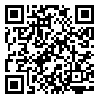BibTeX | RIS | EndNote | Medlars | ProCite | Reference Manager | RefWorks
Send citation to:
URL: http://tumj.tums.ac.ir/article-1-1004-en.html

 , A Molasadeghi Roknabadi
, A Molasadeghi Roknabadi 
 , H Majidi
, H Majidi 
 , Z Jafari
, Z Jafari 
 , S Asadmalayeri
, S Asadmalayeri 
 , Sh Jalaee
, Sh Jalaee 
 , N Noorbakhsh
, N Noorbakhsh 

Background and Aim: Auditory and visual stimuli are the most important factors in communication. It seems during the brain maturation, decrease of visual inputs causes enhancement of somatosensory and auditory cortical responses. In this research latency and amplitude of auditory middle latency responses (AMLR) are studied in blinds and normally sighted subjects.
Materials and Methods: This descriptive-analytical study was performed on 40 congenitally blinds and 40 normally sighted subjects in the range of 14-20 years. All of cases had normal hearing sensitivity and acoustic reflexes without any middle ear disorders. The reason of this age range is the maturation of auditory middle latency responses. Sampling was randomized.
Results: There was significant difference between amplitude of Na, Pa & Nb waves and latency of Na while no significant difference between latency of Pa & Nb in blinds and normally sighted subjects.
Conclusion: Increase of amplitude and decrease of latency of AMLR in blind subjects were due to sensory compensation phenomenon, probably. It seems rate of processing and auditory perception in blinds is better than normally sighted subjects.
| Rights and permissions | |
 |
This work is licensed under a Creative Commons Attribution-NonCommercial 4.0 International License. |



